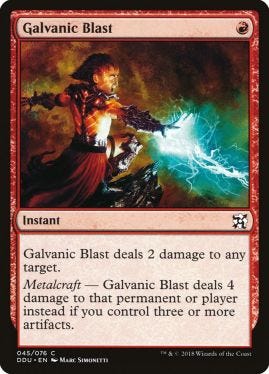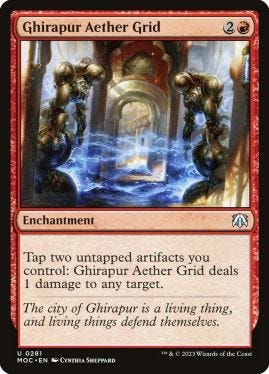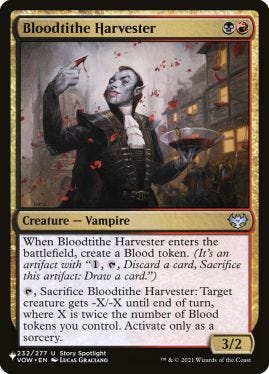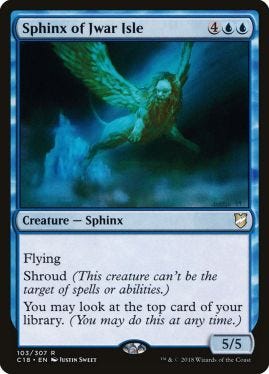If you’ve been a long-time reader of my content, you may recall me talking about Additive Distraction in cube a few times (tl;dr: it’s when you don’t see the forest for the trees on cards.)
For years, I’d intended on making an article about it, since referencing a blurb from a 2016 Mark Rosewater design article defining Additive Distraction when talking about Oath of the Gatewatch was inefficient. I never got around to it, with an initial draft being unfinished on an old computer, unfinished from 2017. This is me finally getting around to finishing it.
MaRo’s above article talks about Oath of the Gatewatch as a set, but this blurb defines the concept of Additive Distraction:
To explain, imagine I made a vanilla creature (this is design so creative hasn't seen it yet):
Bear on Steroids
1G
Creature – Bear
3/4If I showed that around, I'd probably get pretty good responses. We've only done one card with the same cost and stats before (Plant Elemental from Portal) and it required you to sacrifice a Forest. Now imagine I tweak the card:
Geeky Bear on Steroids
1G
Creature – Bear
If you control at least ten artifacts, CARDNAME gains trample.
3/4If I show this card around, I'm going to get a lot fewer positive responses. People will focus on the condition about ten artifacts, and many will come to the conclusion that there isn't really a deck for this card.
But here's the thing: players were excited by the card without the extra line of text. Geeky Bear on Steroids is by every definition of the term "strictly better" than Bear on Steroids from a power standpoint. It has a conditional upside. It's just as good as the original and, in a very narrow case, can be even better.
My point is that how players perceive cards is very connected to how they process what's on it.
With the case of a Geeky Bear on Steroids/Bear on Steroids, the story’s there right on its cover - there’s text that cares about artifacts and plays optimally with a bunch of artifacts in play. But on its own, it can’t tell you exactly how much that text matters and if it's only part of the puzzle of whether the card is good in a given context.
As a hypothetical, Maro’s example is exaggerated on purpose, but it illustrates a point: when seeing something out of the ordinary, it can be hard to parse it outside those factors since that’s where your mental focus lies.
Sphinx of Jwar Isle was at first thought of as a meme card that let you look at the top card of your deck at any time, focusing on that and not that it was a 6 mana 5/5 flier that was hard to interact with (creatures were much worse then, so this was considered good at the time.) Zendikar’s blazing-fast limited format - where the Sphinx and blue as a whole were bad - certainly didn’t help with using limited to outsource reaching that conclusion, but eventually people got there.
It's easy to discount this kind of thinking: "Oh, I don't fall for that, only idiots do LOL" but this isn’t something as simplistic as it may seem. It brought to mind this:
A famous 1999 psychology study was done where participants were tasked with watching a video, where 3 people in white shirts and 3 people in black shirts were passing around basketballs, while an actor in a gorilla suit spends 9 seconds on screen during the video. The participants were tasked to track the number of times that the ball was passed by those in white shirts. When participants were asked, about half of them didn’t notice the person in a gorilla costume. This pattern continued in other similarly conducted experiments and documented in a 2010 book. In the latter experiments, it wasn’t something that could be dismissed by just being ignorant - as even trained professionals in their field fell for the same trap.
Additive Distraction comes from similarly focusing on atypical card text. It’s something I’ve seen, time and time again, during preview season when people are trying to grasp the overall power level of cards using idealized decks and/or game states from being unable to see a card in action. It’s something that I wrote about, regarding linear patterns in evaluation in a 2013 SCG article.
That article’s example with Gemhide Sliver still resonates with me:
“A few years ago, a person who drafted my Pauper cube saw Gemhide Sliver, took it early, and ended up disappointed because there weren’t any other Slivers to go with it.
Was it bad for him to make that assumption, especially in a relatively obscure format like Pauper Cube? The limited experience that most people have with Slivers is in environments where there are multiple Slivers.”
In theory, he could have just asked during the draft, but I’ve found that usually people aren’t going to do that even in the most casual of environments. Even with the knowledge that there wouldn't be the critical mass of good common slivers to make a sliver deck draftable, is it that much of a stretch to assume that there would have been a non-zero number of other playable standalone Slivers?
Oftentimes, it’s hard - both from the drafter and designer perspective - to parse out exactly where the gap is between a card’s idealized state and how it generally/optimally plays in a given cube environment, especially when part of the equation relies on interactions with other cards.
We’ve all seen our fair share of cubes where there’s a card or archetype that looks like a signpost, but it’s to a road to nowhere. Sometimes designer intent doesn’t reflect how cards end up playing out, either because of lacking support or other metagame factors.
Another classic example of Additive Distraction coming from a drafter perspective is from MaRo talking about kicker in the context of Kavu Titan:
During Invasion development I played frequently in the FFL (the Future Future League, where we play many months ahead to try and figure out what the future environment will be like). Because I wasn't the best of deck builders (at least a Spike deck builder; I could hold my own in a Johnny world), I usually got decks from other developers. Randy Buehler was running the FFL at the time, and he gave me a red-green deck to play. In it were four Grizzly Bears . I didn't think anything of it at the time. I then went on to go 4-0 that week. I was the only person with an undefeated record.
During my last match, Randy watched. At some point late in one of the games, I played my Grizzly Bears . After the match was over, Randy informed me that the Grizzly Bears weren't actually Grizzly Bears . They were proxies for Kavu Titan . Armed with this information, the next week I went 2-2. Suffice to say that the R&D guys thought this was the funniest thing ever. The lesson I learned was the importance of using the Kavu Titan s as 2/2s. When I was aggressive with Kavu Titan , my deck performed much better. When I waited to maximize the Kavu Titan s as 5/5 creatures, I lost much of the aggression of my deck and thus some of its power. Week 3, I went 4-0 again.
While this looks like it’s not related to Additive Distraction since the kicker is a very real piece of text, a similar pattern happened, where Mark got overly focused with the kicker mode and played worse as a result.
It's why this article was titled as it is - not so much that people get distracted by card text but discounting their playability from thinking of cards in their idealized state, rather than how a card can realistically play in a cube environment.
If this is all too esoteric, I’ll bring up a few concrete examples.




Galvanic Blast is a nice example as a Shock with “kicker” in its metalcraft. It’s something I’ve liked having in my own cubes since talking to a Kranny, fellow cube content creator of years ago about it, when he’d power up his cube over the holidays and increase his cube’s artifact count. The inclusion of Galvanic Blast, Toolcraft Exemplar and Ghirapur Aether Grid struck my fancy (some of these aged better than others) as potential inclusions, with more cards being printed that incidentally create artifacts helping to make Galvanic Blast’s metalcraft live more often, even in a cube like mine without power.
Thinking more deeply, the question of whether Galvanic Blast can work, power-level wise, in a cube metagame can bring forth other questions:
How often are you able to incidentally get metalcraft in this cube?
How many artifacts/artifact producers does the average/most decks have?
How many artifacts do decks have if they want to work to consistently enable metalcraft? (and is that realistic?)
What (other) payoffs are there for having a lot of artifacts?
Is there a lot of hate to punish a deck with a lot of artifacts?
How good is a base Shock in this metagame?
How much toughness do the creatures generally in this metagame?
For the creatures that die to a Shock - are those creatures “Baneslayers” or “Mulldrifters?”
Are decks w/ small creatures and/or walkers something to worry about?
Is the fail case of it being a Shock acceptable in this metagame?
What role does other removal (in red or other colors) play in making up for Shock being unable to kill creatures with 3+ toughness?
How good is a metalcrafted Galvanic Blast in this metagame?
How does its metalcrafted state line up against the metagame? (Is it significantly above/below rate against other removal in this metagame?)
This isn’t a comprehensive list, but you get the gist of it - these context-driven questions are tough to answer on the fly, especially when looking at something new in a cube from a drafter perspective, and even outside of the draft when looking at a Cube list, those questions are still hard to answer. It can be hard to ask a lot of questions like this internally when it's easier to think “this requires a ton of artifacts. I don't see a lot of artifacts in this pack or and this card isn’t played in a lot of cubes, so it's bad” when looking at an unfamiliar card. And some cubes, realistically, aren’t going to have the critical mass of artifacts/artifact producers to make its metalcraft occur in a realistic manner.
It’s hard to arrive at exact numbers for these questions since so much of it varies on a cube and as tempting as it would be to say “Galvanic Blast is better in a deck with a lot of artifacts,” that’s a given. It’s perfectly ok if you don’t have the exact answers - from either the designer or drafter perspective.
Bloodtithe Harvester is another good example, as a card that was a solid role-player during its time in Standard, and was initially thought to need a “blood theme” with cards like Voldaren Epicure to be playable, but it eventually started seeing play in other formats like Pioneer without other cards that explicitly make blood tokens. It’s been in the MTGO Vintage Cube as a card that quietly brings the room together for decks, as it fills a variety of roles - small creature killer, reanimation enabler, flood insurance and a decent body for times when you don’t care about small creatures.
In cube, despite it not working to its maximized potential like in Standard, where it usually just killed anything, expectations shifted and within the context of it only killing a small creature - it still works well in cubes that don’t have a dedicated “blood theme.” Similarly with Ocelot Pride not necessarily requiring a “lifegain theme” to work since it’s self-contained and both MH3’s Ajani and Tamiyo being plenty powerful even outside of their “optimal” color pair.
Galvanic Discharge is another card that I had seen dismissed as a card that was a bad card that “required an energy theme”, polling surprisingly poorly on the voting on thepaupercube.com. There’s an argument that it could, potentially, lead new drafters astray into thinking there’s an “energy theme” when there isn’t one or the logistical headaches of counting energy - which makes sense as a valid reason to vote against it. But on a pure power-level basis, thinking that a powerful spell is a classic example of focusing on the wrong thing.
The purpose of this article isn't to say “you're wrong about this one specific card” but that, if something operates on an axis that you're not used to, you may want to make sure you're adjusting expectations and looking at things realistically and objectively - both from a designer and drafter perspective.
Thanks for reading! You can find more of my socials on my Linktree.





Awesome article
What a lovely little article! I've caught myself doing this more than a few times, it's nice to see it laid out so clearly. I'm sure reading this will help some people (myself included) learn better card evaluation.